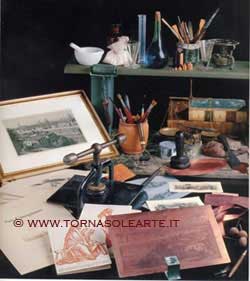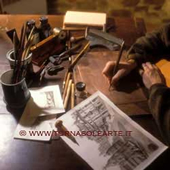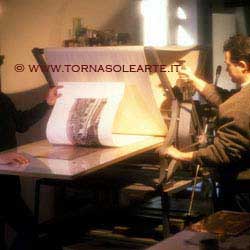TornasoleArte, the Technique of the Etching
![]()
The creation of a Etching is always an emotion | watch the Video

The image of our laboratory of experience, which continues to stand as a workshop of possibilities, where time seems that has stopped.
At favouring it the absolute lack of technology, increasingly contagious in graphic art reproducible.
Etching, technical indirect* of engraving on metal:
It is the ancient name of nitric acid, so called for its corrosive power. With the same name also indicates printing artistic obtained from a matrix, especially copper, or other material, engraved using an acid solution.
The art engraving , worthy of the title for its complexity, sophistication and cultural value, to be fully appreciated, it should be understood and loved.
It is a art of difficult reading because, unlike of painting, is not immediate. The lack of color deprives the eye of that aspect of appeasement that is requires at a artistic object. The difference between the printing and the painting is in some way comparable to that which exists between the impressionist painting and abstract painting (the first aesthetically pleasant, the second often unpleasant at the sight, but full of meanings).
Knowing how to distinguish a technique engraving from another is cause for satisfaction and even more so, a tool to assess the artistic value of the piece taken into account. Who begins to handle art prints, carefully observe the lines and lights, find strengths and weaknesses, compare them, shall enter into a fascinating world from which "risks" to be pleasantly caught.
The process of etching provides that on the plate is coated paint a waterproof and resistant to the action of nitric acid (water strong precisely). With a tip of steel of different thickness the drawing is traced to remove the paint from the surface of the slab.
The plate metal prepared with the drawing is immersed in acid which with its strong corrosive power the eats into correspondence of the signs tracks deprived of protective paint.
Completed last etching the plate is cleared by the paint, inked and impressed. Using the contrary procedure, drawing it that is with the protective varnish and exposing the plate to etching you get a print in which the drawing is white on black (maniera nera). The possibility to draw signs of different sizes, to proceed with several etching and the freedom with which the hand moves on the surface allow to reach clear dark effects and pictorial.
(*) The technique chalcographic (calcos=copper -/- graph=writing) are divided into two groups: the techniques direct, where the excavation of the surface occurs using sharp instruments suitable for the purpose (mechanically action) and the techniques indirect for the excavation where you use as means the "acid" (chemical action).
![]()
The Engraving to Etching

An etching is run by making at first one series of operations on a metal plate to print by it the work finished.
The printing is made using the Hand-Press Chalcographic at star, which compresses, pressing the sheet of paper moistened, against the matrix inked earlier.
The various stages of Engraving consists of the following operations:
-
Is covers uniformly the layer of copper (already polished in advance a surface with care), on both sides with a paint-resistant acid solution.
-
On Side mirror polished of the slab you draw so speculate with steel tips of different sizes, carrying away the paint at correspondence of the lines that contribute to the formation of the drawing, without leaving any sign on the metal.
-
Once you run the sketch, it puts into practice the "etching". The plate is immersed in a bath of acid so that the chemical reaction takes place: in the lines where was taken away the paint, the solution used for etching (mordant Dutch-based hydrochloric acid) is taken on metal and grooves opening of thin furrows.
The result of etching depends on the time of immersion and the degree of concentration of the acid, its preparation, the characteristic of the metal, and the outside temperature. To obtain various shades and nuances or to highlight the various floors of the drawing, on the same matrix more times you run the operations 1, 2 and 3, so that the various parts of the drawing suffer the desired effects of etching. Made the ultimate bathroom, the paint is removed from the metal plate, clean carefully, controlled and then prepared for the pressing.
To deepen own knowledge about what the artist makes for engrave an etching on copper plate is inviting to visit the dedicated section:
---» The Engraving to Etching. Guided procedure with the example of images from our laboratory. «---
![]()
The Chalcographic Printing

To transfer the drawing engraved of a matrix on the card, you must have an Chalcographic suitable press.
Usually consists of a surface metal and wood, pressed and made scroll horizontally between two large and heavy metal cylinders put into action by hand using a special grip star.
The various stages of Printing consists of the following operations:
-
We must first lay a uniform layer of ink on the matrix, so that it penetrates into all the furrows present. Then we must remove the excess ink, helping at first with the cotton fabric called tarlatan, then finish off with paper thin, so that the parties smooth, will be clear in the final press, they are completely clean.
-
The matrix is positioned upon the surface of printing press, with the side and engraved ink upwards and upon it the paper is posizioned for printing, special paper manufactured by hand in pure cotton, which is moistened before (not wet) to make it softer.
-
Making turn the cylinder of manual printing press at star, the matrix impregnated with ink and the paper moistened are pressed against each other, and at the exit from passing through the two horizontal cylinderers the impressed printing can be thoroughly detached and separate lifting it from a corner.
-
After molding of the matrix must be completely dry the ink on the sheet of impressed print just about placing a special drying rack, then you must again dampen the sheet and dry them under pressure between two sheets of thick cardboard pressed for to assume shape laid and regular.
In this way you can print from a single matrix a limited number of copies before the signs incised on the same will flatten, so as to become unserviceable. All prints marked by the same matrix are signed and numbered by the artist strictly, including the proofs, with two numbers written with a pencil (1/100, 2 /100, 3 /100 etc.), of which the first is the progressive number of the same print, the second is the total number (limited edition) of printed copies or to print. Each Original Print distributed by TornasoleArte is accompanied by a Certificate of Authenticity -›››
To deepen own knowledge about what the artist makes for produce each single print from a copper plate is inviting to visit the section:
---» The Chalcographic Printing. Guided procedure with the example of images from our laboratory. «---


